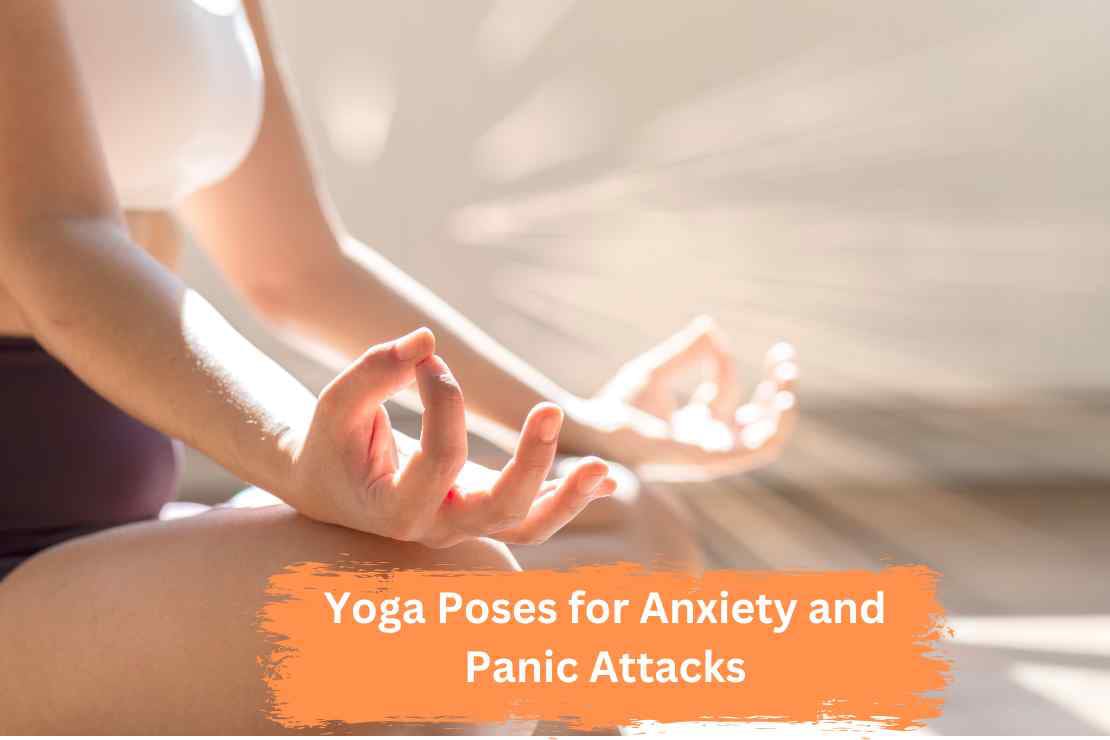
Anxiety and panic attacks can feel overwhelming, but incorporating yoga poses into your daily routine can be a powerful way to manage these challenges. Yoga, with its emphasis on mindful movement and controlled breathing, helps to calm the mind and reduce physical tension. In this guide, we will explore some of the most effective yoga poses for anxiety and panic attacks, their benefits, and how you can incorporate them into your life.
Understanding Anxiety and Panic Attacks
All people occasionally experience anxiety, which is a normal reaction to stress. However, chronic anxiety can disrupt daily life and lead to health issues. Panic attacks, on the other hand, are sudden episodes of intense fear or discomfort, often accompanied by physical symptoms such as a racing heart, sweating, and difficulty breathing. These episodes can feel debilitating and may occur without an obvious trigger.
Yoga helps manage both anxiety and panic attacks by addressing the root causes of stress and promoting relaxation. By engaging the body and mind, yoga offers tools to reduce anxiety levels and improve emotional resilience.
How Yoga Helps with Anxiety and Panic Attacks
The practice of yoga unites the body, mind, and spirit in a holistic way. Yoga poses can help manage anxiety and panic attacks in the following ways:
- Regulates Breathing: Breathing exercises, known as pranayama, focus on slowing and deepening your breath. This calms the “fight or flight” response and helps you feel more grounded.
- Reduces Muscle Tension: Anxiety often manifests physically as tightness or tension in the muscles. Yoga stretches and releases these areas of tension, promoting relaxation.
- Promotes Mindfulness: Many yoga practices emphasize staying in the present moment. This mindfulness can help break the cycle of racing thoughts and focus on the “now.”
- Activates the Parasympathetic Nervous System: This system is responsible for “rest and digest” functions, counteracting the stress-induced “fight or flight” response. Yoga helps activate this system to bring a sense of calm and balance.
Preparing for Your Yoga Practice
To maximize the benefits of yoga, it’s essential to prepare properly. Here’s how you can set yourself up for a successful practice:
- Choose a Quiet Space: Ensure your environment is free from distractions. A peaceful setting enhances your focus and relaxation.
- Wear Comfortable Clothing: Loose, breathable clothing allows for ease of movement and comfort during stretches and poses.
- Use a Yoga Mat: A non-slip mat provides a stable surface for your practice and prevents injuries.
- Keep Hydrated: Have a water bottle nearby to stay hydrated, especially if you’re practicing for an extended period.
Tips for Beginners
If yoga is new to you, begin with basic poses and work your way up to more complex ones. Listen to your body and avoid overexertion. Yoga is a journey, and consistency is more important than perfection.
Top Yoga Poses for Anxiety and Panic Attacks
Child’s Pose (Balasana)
Benefits: Child’s Pose is a grounding and calming posture that helps relieve stress and tension in the back, shoulders, and neck. It’s especially useful for creating a sense of safety and relaxation.
How to Do It:
- Kneel on the mat with your knees slightly apart and big toes touching.
- Stretch your arms out in front of you while sitting back on your heels.
- Breathe deeply and slowly while placing your forehead on the mat.
- Stay in this pose for 1-2 minutes, focusing on the sensation of your breath.
Cat-Cow Pose (Marjaryasana-Bitilasana)
Benefits: This dynamic movement between Cat and Cow Poses helps relieve tension in the spine and synchronizes movement with breath. It’s ideal for calming the nervous system.
How to Do It:
- Begin on your hands beneath your shoulders and knees beneath your hips.
- Lift your head and tailbone, arch your back, and take a deep breath (Cow Pose).
- In Cat Pose, exhale, turn your back, and tuck your chin into your chest.
- Move slowly and mindfully as you repeat the flow five to ten times.
Downward-Facing Dog (Adho Mukha Svanasana)
Benefits: This pose stretches and strengthens the entire body while improving circulation. It’s known to energize the body and reduce symptoms of stress.
How to Do It:
- Begin on all fours and lift your hips toward the ceiling.
- As much as you can, straighten your legs and push your heels down.
- Press into your palms with a wide spread of fingers.
- Hold this position for 30 to 60 seconds while taking deep breaths.
Bridge Pose (Setu Bandhasana)
Benefits: Bridge Pose opens the chest and reduces tension in the back and shoulders. It also promotes relaxation and alleviates mild depression.
How to Do It:
- Place your feet flat on the floor and bend your knees while lying on your back.
- Place your arms palms down next to your body.
- Press into your feet and lift your hips toward the ceiling.
- After 30 to 60 seconds of holding the pose, slowly return your hips to the mat.
Breathing Techniques for Anxiety Relief
Breathing exercises are a vital part of yoga and can be practiced independently. These techniques help calm the mind and reduce physical symptoms of anxiety.
Alternate Nostril Breathing (Nadi Shodhana)
Benefits: This technique balances the left and right hemispheres of the brain, promoting mental clarity and relaxation.
How to Do It:
- Sit comfortably with a straight spine.
- Take a deep breath through your left nostril while using your thumb to close your right nostril.
- Let go of your thumb and use your ring finger to close your left nostril.
- Exhale through your right nostril.
- Continue alternating nostrils for 1-2 minutes.
Deep Belly Breathing
Benefits: This practice activates the body’s relaxation response and reduces feelings of anxiety.
How to Do It:
- Sit or lie down in a comfortable position.
- Press one hand to your belly and the other to your chest.
- Take a deep breath through your nose and feel your stomach rise.
- Breathe out slowly through your mouth while allowing your stomach to drop.
- Repeat for 5-10 minutes, maintaining a slow and steady rhythm.
Creating a Daily Routine
To experience the full benefits of yoga, consistency is essential. Here’s how to establish a routine:
- Set a Schedule: Practice at the same time every day, whether it’s in the morning to energize or in the evening to unwind.
- Start Small: Begin with short sessions, such as 10-15 minutes, and gradually increase the duration.
- Combine with Other Practices: Enhance your routine with complementary practices like journaling, meditation, or aromatherapy.
Additional Lifestyle Tips for Managing Anxiety
While yoga is a powerful tool, incorporating these lifestyle changes can further improve your mental health:
- Healthy Eating: A balanced diet rich in nutrients supports overall well-being. Avoid excessive caffeine and sugar, which can exacerbate anxiety.
- Adequate Sleep: Prioritize 7-9 hours of quality sleep each night to restore your body and mind.
- Regular Exercise: In addition to yoga, engage in activities like walking, swimming, or dancing to release endorphins.
- Mindfulness Practices: Activities such as meditation, gratitude journaling, or spending time in nature can reduce stress and enhance mental clarity.
Common Mistakes to Avoid
When practicing yoga for anxiety, watch out for these pitfalls:
- Skipping Warm-Ups: Always warm up your body to prevent injuries and prepare for deeper stretches.
- Holding Your Breath: Focus on breathing deeply and consistently throughout your practice.
- Comparing Yourself to Others: Yoga is a personal journey. Concentrate on your progress rather than comparing yourself to others.
The Science Behind Yoga for Anxiety
Scientific research supports the effectiveness of yoga in managing anxiety. Studies show that yoga reduces cortisol levels (the stress hormone) and increases GABA (a neurotransmitter associated with relaxation). Regular practice enhances the brain’s ability to handle stress, improves emotional regulation, and fosters a sense of inner peace.
Conclusion
Incorporating yoga poses for anxiety and panic attacks into your daily routine can lead to profound mental and physical benefits. From calming breathing techniques to restorative poses, yoga offers a holistic approach to managing stress and promoting a sense of peace. Start your journey today and experience the transformative power of yoga. Remember, consistency is the key to reaping these benefits, so make yoga a cherished part of your lifestyle.
FAQs
1. What are the best yoga poses for anxiety?
Child’s Pose, Cat-Cow Pose, and Bridge Pose are some of the most effective yoga poses to reduce anxiety.
2. Can yoga help with panic attacks?
Yes, yoga helps manage panic attacks by calming the nervous system and promoting relaxation through mindful breathing and movement.
3. How often should I practice yoga for anxiety relief?
Practicing yoga 3-5 times a week, even for 15-20 minutes, can significantly reduce anxiety symptoms over time.
4. What is the role of breathing in yoga for anxiety?
Breathing exercises like Alternate Nostril Breathing and Deep Belly Breathing regulate stress responses and foster mental clarity.
5. Is yoga better than meditation for anxiety?
Both yoga and meditation are effective. Yoga combines physical movement with mindfulness, while meditation focuses solely on mental clarity.
6. Can beginners benefit from yoga for anxiety?
Absolutely! Beginners can start with simple poses and breathing exercises, gradually building their practice for better results.


